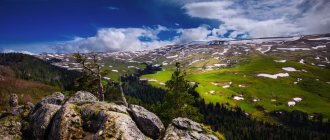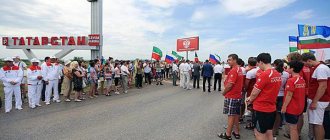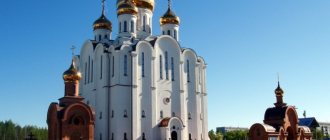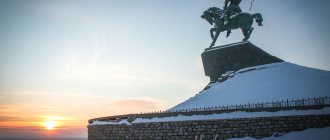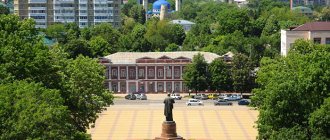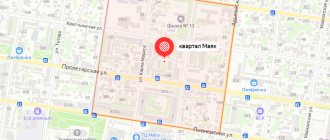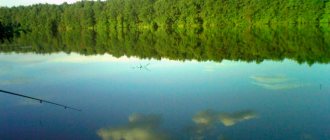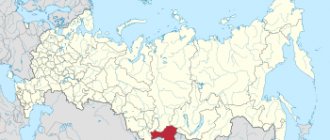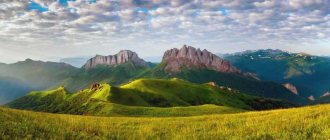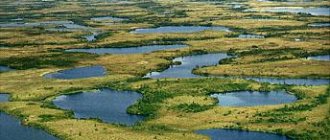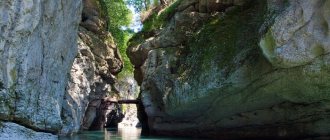| Republic of Adygea |
The Republic of Adygea
, part of the Southern Federal District of Russia, is part of the North Caucasus economic region. The capital is Maykop. It is located in the south of the European part, in the northwestern part of the Caucasus, the northern part is on the Kuban Plain, and the southern part is on the slopes of the Greater Caucasus. The territory of the republic is surrounded on all sides by the territory of the Krasnodar Territory. Territory area 7.8 thousand square meters. km, population 453.4 thousand people. (2018)
- On the map: Yandex.Map, Google map
The Adygs as a people with a single language and culture emerged by the 10th century; they occupied the territory from the Taman Peninsula to Abkhazia and to the Azov region and the Kuban River.
The self-name “Adyghe” presumably reflects the name of the Zikhi tribe through the intermediate form a-dzyge - this is confirmed by the Abkhaz name of the Adygs, Azykhu, and the Georgian name, Dzhiki. Zikhi are mentioned in the “Geography” (Book XII) of Strabo (18 BC), later found in the works of Greek and Latin authors, in Byzantine sources of the 6th-10th centuries, disappearing from literature from the 13th century, when new ones appeared The names of the Circassians are Kasogs, Circassians. Subsequently, the formation and isolation of ethnic groups continued. In the 16th-18th centuries, wars against the Circassians were waged by the Ottoman Empire and the Crimean Khanate, which forced them to seek the protection of the Russian state. In 1552-1557, several Adyghe embassies arrived in Moscow. The chronicles are the only sources by which one can judge the details of the Russian-Adyghe negotiations. It was about protection from the attacks of the Crimean Tatars. Connections between the Circassians and Russia were established through the Nogai rulers, who were oriented toward Rus'. The appeal of the Circassians to Moscow did not mean their immediate entry into Russia. The inclusion of the Circassians in the Russian administrative-political system began only after the end of the Caucasian War (1817-1864).
The Adygs lived in separate large tribes or tribal unions. Each tribe occupied its own territory and had different customs. Historically, there was a continuous process of consolidation of tribes into a single nation. Sources from the 10th century mention three large tribal associations: Zikhia, Papagia and Kasakhia. In the 16th-17th centuries, unsuccessful attempts were made to unite the Circassians into a single state. The 18th century was marked by widespread colonization of the North. Caucasus by Russian and Ukrainian settlers. Circassia was one of the theaters of the Russian-Turkish wars of 1787-1791 and 1806-1812. In difficult conditions of confrontation between powers pursuing an expansionist policy, the Circassians waged an armed war for their independence. According to the Iasi (1791) and Bucharest (1812) peace treaties concluded between Russia and Turkey, Circassia was under the control of the Ottoman Empire. At the same time, the Russian Empire did not abandon its interests in this region, pursuing its policy through both economic and military means.
As a result of the Russian-Caucasian War of 1817-1864, most of the Circassians became muhajirs, moving within the Ottoman Empire. The rest were settled on flat lands on the left bank of the Kuban.
After the October Revolution of 1917, the territory of Adygea from May 1918 was part of the Kuban-Black Sea Soviet Republic.
On July 27, 1922, the Adygea (Circassian) Autonomous Region
on the territory of the Maykop and Yekaterinodar departments of the Kuban-Black Sea region, whose authorities were located in the city of Krasnodar.
On August 13, 1928, it was renamed the Adygea Autonomous Region
.
From August 2, 1924 to December 28, 1934, the region was part of the North Caucasus Territory, then until September 13, 1937 it was part of the Azov-Black Sea Territory, then it became part of the Krasnodar Territory.
On April 10, 1936, the center of the region was moved to the city of Maykop, which was included in the Adygea Autonomous Region.
On April 28, 1962, the Tula (now Maikop) district was transferred to the region from the Krasnodar Territory.
On December 15, 1990, the Adygea Autonomous Region seceded from the Krasnodar Territory.
On July 3, 1991, the autonomous region was transformed into the Republic of Adygea.
On March 10, 1995, the Legislative Assembly (Khase) approved the Constitution of the Republic of Adygea.
The Republic of Adygea consists of seven districts and two cities of republican subordination, Adygeisk and Maykop.
What holiday is it today?
December 16, 2021, Thursday
Today are holidays, events: Events that happened on December 16 in the world, in different years Tomorrow: Day of Strategic Missile Forces Day of Employees of the State Courier Service Memorable date in the military history of Russia: Capture of the Ochakov fortress in 1788
Today is the Orthodox holiday of the Prophet Zephaniah. Reverend Savva of Storozhevsky, Zvenigorod. Martyr Angelis... Tomorrow: Great Martyr Barbara and Martyr Juliania of Iliopolis. Venerable John of Damascus...
Today is a national holiday: Day of World Silence and Silence... Tomorrow: Barbarian Day...
Seasons
Seasons, four periods of the year (spring, summer, autumn and winter) characterized by certain average temperatures. The period during which the Sun passes through one of these sectors is called the season. Spring in the Northern Hemisphere and autumn in the Southern Hemisphere begin when the Sun passes through the initial circle of declination and its right ascension is 0° (vernal equinox). Summer in the Northern Hemisphere and winter in the Southern Hemisphere occur when the sun's right ascension is 90° (summer solstice). Autumn in the Northern Hemisphere and spring in the Southern Hemisphere begin when the sun's right ascension is 180° (autumnal equinox). The beginning of winter in the Northern Hemisphere and summer in the Southern Hemisphere is considered to be the winter solstice, when the direct ascension of the Sun is 270°... Next: Seasons. Russian folk calendar. Monthly words...
Population
In 1999, the population of Adygea was 449.3 thousand people, of which 95.4 thousand were Adygeis (Adygs), self-name - Adyge (Old Russian Kasogi, Old Circassians), local ethnographic and dialect differences remain: Abadzekhs, Bzhedugs , Shapsugs, Besleneyevtsy, Zhaneevtsy, Natukhaytsy, Temirgoyevtsy, Khatukayevtsy, Egerukayevtsy, Mamkheg, Makhoshevtsy, Khakuchi. Currently, Adygea is inhabited mainly by four subethnic groups - Abadzekhs, Bzhedugs, Shapsugs, Temirgoys, representatives of other groups are settled among these subethnic groups. The republic is also home to Russians - 293.6 thousand, Ukrainians - 13.8 thousand, Armenians - 10.5 thousand, Belarusians - 2.7 thousand, Tatars - 2.7 thousand, Germans - 1.8 thousand ., Greeks - 1.6 thousand, Gypsies - 1.1 thousand.
Western Adygs (inhabiting Adygea) speak the Adyghe language (four dialects), which belongs to the Adyghe group of Western Caucasian languages. The official languages are Russian and Adyghe.
Folk calendar about every day
Every day one season always replaces another and this determines a person’s way of life. In connection with this, a folk calendar was formed in which there were practically no nameless, unmarked days. Every day was special, had its own purpose. All this was determined by climate conditions and astrological phenomena.
A calendar is a system for counting periods of time. The first calendars arose a long time ago, in ancient times, because there was a need to measure time. The word calendar comes from the Latin words caleo - to proclaim and calendarium - debt book. This is due to the fact that in Ancient Rome the beginning of each month was especially proclaimed, and because it was customary to pay debts on the first day of the month. Different peoples counted time differently. Some calendars are based on the changing phases of the moon - lunar calendars; in others - the change of seasons - sunny; in others, the length of the year was coordinated with the change of seasons, and the counting of months was associated with the phases of the Moon. Such calendars are called lunisolar.
In Rus', the calendar was called a monthly calendar. Every day, the month book covered the entire year of peasant life, “describing” day by day, month after month, where each day had its own holidays or weekdays, customs and superstitions, traditions and rituals, natural signs and phenomena. The cyclical nature of the calendar is reminiscent of human life, where spring is youth, summer is heyday, autumn is the time of harvesting fruits (it’s good if there are some, otherwise you can live your life without collecting fruits), winter is the time of wisdom and peace. This cyclicality and rhythm determined the way of life of the farmer. The folk calendar was an agricultural calendar, which was reflected in the names of the months, folk signs, rituals and customs. Even the determination of the timing and duration of the seasons is associated with real climatic conditions. Hence the discrepancy between the names of the months in different areas... Next: Folk calendar...
Infrastructure...
The infrastructure in Adygea is quite normal and developed. There are schools, kindergartens, shops and large shopping centers. Especially are the Mega Adygea shopping center where the famous IKEA is located https://mega.ru/adygeya/, Leroy Merlin https://krasnodar.leroymerlin.ru/shop/krasnodar-adygeya/, Decathlon https://www.decathlon. ru/ We often visit them ourselves))
By the way, the development of infrastructure near the Mega Adygea shopping center is constantly ongoing. In the near future there will be a lake with walking areas. Additional entertainment areas. Currently still under construction.
At the same time, there are many different trading enterprises and shops for every taste. Located along Turgenevskoye Highway. Finding a job in Adygea is also possible. Various projects are under construction and if you are a builder, you certainly won’t be left without work! In addition, as I wrote above, trade is developed. Which is also a good option for employment. Transport runs steadily to Krasnodar, minibuses - 2, 67, 95, 39, 61, 62, 7a. Also buses that go from different areas of Krasnodar to the Mega Adygea shopping center - 414, 444, 710, 7a.
Just 15 minutes by transport. Of course there are traffic jams across bridges. Especially during rush hour. The roads are not good everywhere. Laying asphalt in the residential areas of New Adygea and Yablonovsky is proceeding at a slow pace.
Parking near the Mega Adygea shopping center
Inside the Mega Adygea shopping center
Inside the Mega Adygea shopping center
Fishing calendar for every day
The fishing calendar should not be taken as an absolutely indisputable truth. Fish biting is greatly influenced by a whole range of natural factors, as well as the influence on the nature of man himself. You must not forget that the fish’s bite depends and is determined not only by the calendar dates and biological cycles of their life, reflected in the calendar, but also, no less, by the state of their habitat; the bite also depends on weather conditions: air and water temperatures, cloudiness, wind direction and strength, etc... Next: Fishing calendar...
Republic of Adygea
Republic of Adygea •
The Republic of Adygea is located on the picturesque slopes of the Caucasus Range, in the valley of the Kuban and Laba rivers, not far from two seas: the Azov and the Black. Its territory occupies 7.8 thousand square meters. km (0.04% of the territory of the Russian Federation). Currently, the republic includes 2 urban districts: Maykop and Adygeisk, 7 municipal districts (Maikop, Koshekhablsky, Krasnogvardeysky, Giaginsky, Teuchezhsky, Takhtamukaysky, Shovgenovsky), 3 urban settlements, 48 rural settlements.
More than one third of the area of Adygea is occupied by specially protected natural areas of various statuses and categories. The six largest specially protected natural areas, representing mountainous lands rare in terms of preservation and level of biological diversity (14% of the total area of Adygea), were included in the UNESCO World Natural Heritage List in December 1999 as part of the “Western Caucasus” nomination, which confirmed the special the value and global significance of these objects. This is the Caucasian State Natural Biosphere Reserve, including 73,356 hectares of its land located in Adygea, its protective zone, the Bolshoy Tkhach natural park, the natural monuments “Upper reaches of the Pshekha and Pshekhashkha rivers”, “Upper reaches of the Tsitsa river”, “Buiny ridge” "
The Republic of Adygea is famous for the fertility of its land, mild climate, generosity and hospitality of local residents.
Truly Adygea is a unique piece of paradise: the western part of the Greater Caucasus has no equal in the diversity of flora and fauna and their preservation not only in the Caucasus region, but also among other mountainous regions of Europe and Western Asia. This is an area where a large number of endangered rare, endemic and relict species of plants and animals are concentrated.
“The deeper the roots, the higher the crown,” they say. This is an undeniable truth. The traditions of Adyghe etiquette Adyghe Khabze are rooted in ancient times. In this beautiful corner of Russia, the picturesque beauty of nature and the spiritual beauty of the people, proud of their ancient origins and national culture, are intertwined.
Numerous historical and cultural monuments of different eras cover modern Adygea with legends. This is the famous medieval Silk Road from Europe to Asia, and the Old Circassian Gardens, and the inexhaustible source of national identity, the Nart epic - a code of laws of honor and a repository of knowledge.
The nature of Adygea is amazing and beautiful and leaves no one indifferent. Majestic mountains in snow-white hats of eternal snow, mountain slopes covered with mighty forests and alpine meadows, wide steppes, rivers and lakes, cool groves and clear springs, huge trees, rare plants - this is how nature generously endowed our land.
The republic's ethnic and national composition is rich and diverse. The Adygs, who gave the name to the republic, are the oldest inhabitants of the Northwestern Caucasus, known in Europe and the East since the 13th century as Circassians. Their ancestors at different times bore the ethnonyms: Kasogs, Zikhs, Meots. In addition to the Circassians, an autochthonous people, and Russians, who make up the majority, representatives of more than 100 nationalities live in it. The population of the Republic of Adygea, according to the 2010 census, is 439,996 people.
Adygea is the pearl of tourism . The republic has everything for active recreation and eco-tourism. This is the most beautiful recreational center in the Western Caucasus - Guzeripl district. Preserved ancient forests, with an average age of trees of 200-300 years, give this area a fabulous picturesqueness, a feeling of real pristine nature. Small tourism businesses and rural tourism are developing dynamically here. The famous water tourism all-around and rafting competitions “Interrali-Belaya” have become a traditional tourist and sports festival. In 2006, the village of Guzeripl successfully hosted the European Rafting Championship. Adygea is also of interest to fans of winter ski trips. The relief of the snowy slopes of the Lago-Naki plateau is so diverse that both amateurs and professional athletes find routes that suit their strengths and capabilities.
The local mountains also attract hang gliders. In 1991, the first hang gliding championship in Russia took place in the republic. Excellent rock routes of different difficulty categories attract climbers from all over Russia and the Commonwealth countries like a magnet. Speleotourism is developed. There are 125 known karst caves and mines in Adygea.
The most famous brand has long been the Lago-Naki plateau. The Lagonaki recreational area is located between the Belaya and Pshekha rivers and is an isolated limestone region of the Western Caucasus. All forms of glacial karst relief types are represented in a relatively small area. In the limestone massifs of the northern part of the territory, numerous caves and cavities, including the longest and deepest in Russia (more than 1600 m deep and 15 km long), form complex underground systems with rivers, lakes and waterfalls. On outcrops of rocks of different ages and compositions one can observe the most interesting remains of extinct organisms. Thus, the valley of the Belaya River (the left tributary of the Kuban), thanks to numerous finds of giant ammonite shells (sometimes more than 1 m in diameter), gained worldwide fame.
The upper reaches of the rivers form deep river canyons - the incredibly beautiful Guam Gorge, Mezmai Canyon, Tsitsa Gorge. This is a real paradise for hiking and mountain tourism, mountaineering, and rock climbing. The routes are designed in such a way as to minimally disturb the nature of the reserve and provide the traveler with an acquaintance with the whole variety of natural landscapes. This is a wonderful country of green mountains with slopes that retain patches of white snowfields, the edge of the whitest clouds and fresh mountain air until mid-summer.
Natural and economic resources
The territory of the republic has the following types of mineral raw materials: 1. Fuel and energy resources are represented by hydrocarbon raw materials (natural gas, oil and gas condensate). 2. Ore minerals are currently the least studied and are represented by insignificant reserves and occurrences of non-ferrous, ferrous and noble metals: manifestations of ore mineralization of molybdenum, tungsten, polymetals (lead, zinc, copper), indigenous and placer occurrences of noble metals (gold, silver ) and manganese ores of carbonate and oxidized types. 3. Non-metallic minerals are represented by a wide variety of types: - industrial and mining raw materials (refractory and medicinal clays, technological limestones for the sugar industry, medical gypsum and for the cement industry, glauconite sandstones, phosphorites, zeolites, barite, piezo-optical quartz, quartz sand and dolomites for the glass industry); — building materials (building gypsum, marls for cement production, facing and decorative stones, red, marbled and dolomitized limestones, dolomites, gypsum and anhydrites, sandstones, granites, amphibolites, tuffs, serpentinites, listvenites); - common minerals (construction sands, boulder-gravel-sand mixtures, construction limestones, brick, tile and expanded clay). The structure of the mineral and raw materials potential of the industrial mineral reserves of the republic in percentage terms is: - fuel and energy resources - 22.70%; — groundwater — 22.58%; — non-metallic minerals — 54.72%.
Valuable resources are fresh and mineralized thermal underground waters that come to the surface - iodine-bromine, sodium chloride, sulfate-chloride, hydrogen sulfide and others, close in their composition and therapeutic effect to the mineral waters of the Caucasian Mineral Waters region, Sochi and other Russian resorts . This opens up significant opportunities for our region: mineral springs make Adygea an attractive sanatorium and resort area.
Industry . Adygea is an industrial-agrarian republic with a mixed economy represented by various forms of ownership. The basic industries include mechanical engineering, metalworking, food, forestry and woodworking, fuel, and electric power. Small businesses are dominated by trade and public catering.
In the industrial structure, the largest share falls on manufacturing - 76.4%, production and distribution of electricity, gas and water - 18.2%, mining - 5.4%.
The leading industry is the food industry, whose share in total production is more than 35%. They produce canned meat, fruits and vegetables, confectionery, pasta, wine and vodka products, various dairy and meat products. The presence of forest resources in the republic led to the development of the woodworking and pulp and paper industries, the products of which are industrial wood and products made from it, parquet, semi-cellulose, and cardboard.
Mechanical engineering and metalworking enterprises produce and supply medium and heavy spur gearboxes, technological equipment for logging, metal-cutting and woodworking machines, machine tools, etc. to various regions of the country and beyond its borders. Foreign economic activity is carried out in the republic, joint ventures of trade and public catering continue to be created , production of consumer goods, tourism.
Agriculture is one of the main directions of economic development. A healthy climate and fertile land ensure environmental purity and impeccable quality of agricultural products. We are especially proud of the northernmost tea in the world. And every Russian knows Adyghe cheese.
The volume of agricultural production by all agricultural producers (agricultural enterprises, households, farmers) in 2014 amounted to 15,548.2 million rubles, or 101.3% of the 2013 level. The leading place is occupied by the cultivation and processing of grain, sugar beets, oilseeds and essential oil crops, vegetables and fruits; breeding of cattle, pigs, sheep, poultry, horse breeding.
The climate of the republic is very diverse. In its northern lowland part the climate is temperate continental, in the foothills it is warm and humid, and in the southern part there is a cold highland climate. The number of days with precipitation per year is 115 - 150. Warm days a year are 200 - 210, clear days - from 200 to 250. The average temperature in January is −2 °C, July is +28 °C. Precipitation is about 700 mm per year.
| Federal District | Southern |
| Economic region | North Caucasian |
| Official languages | Russian, Adyghe |
| Head of the Republic of Adygea | Kumpilov Murat Karalbievich |
| Chairman of the State Council-Khase of the Republic of Adygea | Narozhny Vladimir Ivanovich |
| Deputy Chairman of the State Council-Khase of the Republic of Adygea | Ashev Mukhamed Dzhumaldinovich |
| Deputy Chairman of the State Council-Khase of the Republic of Adygea | Savv Asker Khadzhumarovich |
| Prime Minister of the Republic of Adygea | Mitrofanov Gennady Alekseevich |
| Hymn | Anthem of the Republic of Adygea |
| Code of the subject of the Russian Federation | 01 |
| Timezone | MSK (UTC+4) |
Orthodox calendar about every day
Orthodox calendar: Orthodox, Church and Christian holidays.
The church year is an alternation of weekdays and holidays. On weekdays, a person is called to work “by the sweat of his brow to earn his bread.” Holidays are given in order to feel liberation, to rise above the bustle and routine of the world, to feel involved in the highest of worlds, “where there are no illnesses, sorrows and sighs, but endless life.” Since ancient times, holiday cycles have been associated with the seasons. The pagans associated them with the worship of the forces of nature, the cult of which in the Old Testament was replaced by gratitude to the Creator for the universe. And although the connection between holidays and the seasons has not completely lost its power, since God is present in everything, in the plant and animal world, in human works, it nevertheless faded into the background, giving way to a spiritual foundation built on the Sacred Scriptures. The history of Orthodox holidays dates back to the times of the Old Testament. Each of the Orthodox holidays is dedicated to the remembrance of the most important events in the life of Jesus Christ and the Mother of God, as well as the memory of saints... Next: Orthodox calendar...
Attractions
Tourism here is intended for lovers of adrenaline and vivid impressions, as well as lovers of very beautiful wildlife. These are caves and turbulent rivers, peaks. You can fly a hang glider, ride a quad bike, or ride a horse through the gorges .
Some of the most popular attractions of the Republic of Adygea (and this is not the entire list):
- Khadzhokh Gorge of the Belaya River
- Lago-Naki
- Waterfalls of the Rufabgo River
- Savranskaya Ropeway
- Mysterious dolmens
- Rope adventure park "Tethys"
- St. Michael Athos Monastery
- Devil's finger rock
- Gorge and waterfalls of the Mishoko River
- Museum of Nature of the Caucasian Reserve
- Granite gorge of the Belaya River
- Lagonaki Highlands (Lago-Naki Plateau)
- Caves of the Lagonaki Highlands
- Fisht-Oshtensky mountain range
- Valley of the Ammonites
Russian folk calendar for every day
The word “sign” comes from the word “notice”, i.e. observe. As a result of observing what happens around a person every day, he accumulates life experience. This knowledge was passed down from generation to generation, carefully preserved and people trusted it as a sacred book. Many signs have come to us from the depths of centuries without losing their knowledge. Each of us is free to choose: to dismiss all this as an absurd superstition or to take a closer look at the signs and take the centuries-old experience of generations more seriously. Most of us, when taking exams, ask them to scold them, boasting about some kind of good fortune or luck, spit so as not to jinx them or knock on wood, take a detour if a black cat crossed the road, are afraid of the number 13 and much more. And who among us does not have lucky things, numbers? Who has never resorted to the help of fate at least once in their life, who has not believed in secrets? It’s as if everything connected with signs is hidden somewhere deep in our subconscious. Often we remember them mechanically, unconsciously, or just as a joke. But, undoubtedly, the signs contain a lot of accurate knowledge and practical wisdom of our ancestors. They cover all the characteristic, often difficult to perceive, natural phenomena. Signs have preserved a lot of what was in old folk holidays and customs; they help predict the weather, grow crops... Next: Folk signs...
Read also:
Residential complexes and developers of Krasnodar, Moving to Krasnodar, Miscellaneous
Reviews and comments - one comment
- Answer
04.10.2021Denis Maslennikov
I don’t know who likes it, but we like Adygea. Over the past 5-7 years, Yablonovsky and New Adygea have developed and built up beyond recognition. And Krasnodar is very close, and the CENTER of Krasnodar. Therefore, everyone must decide and draw conclusions for themselves.
2
Holiday calendar, dates and events of the year
All state and professional holidays in Russia, including significant World and International holidays, and other equally interesting holidays and events about every day.
The holiday has always kept pace with the history of mankind. Social time can be divided into three types: everyday life (weekdays), weekends and holidays. Everyday life is a series of practices repeated day after day and every day (work). Weekends are regular breaks from the rush of everyday life. It is believed that on weekends a person should restore his strength after working days. Day off, non-working day. A holiday is a day of celebration established in honor or in memory of someone or something. A day or series of days celebrated by the church in memory of a religious event or saint... Next: Calendar...
Prayer book, Orthodox prayers for every day
Prayer is the most powerful means for healing all illnesses - both physical and mental. Prayers can be laudatory or grateful, petitionary and repentant. If we have offended God, sinned, we must ask Him for forgiveness, that is, repent. Such prayers are called repentant prayers. If everything is fine with us, if we and our loved ones are healthy and prosperous, if we have a place to live, something to wear, something to eat, we must glorify and thank God for this. Such prayers are called praise or thanksgiving. If some misfortune, illness, trouble or need happens, you need to ask God for help. Such prayers are called petitionary... Next: Orthodox prayers...
Zodiac, astrological, eastern calendar. Zodiac signs
In ancient times, to establish the calendar, priests used knowledge of the positions of all the planets. Before the reform of Peter 1, the New Year was celebrated on the Day of the Autumn Equinox. On this day, according to ancient legend, the most peaceful treaty was concluded between the Great Race (ancient Slavs) and the Great Dragon (ancient Chinese) and it was approximately 7518 years ago... For the ancient Slavs, the calendar month corresponded to the lunar cycle from new moon to new moon, taking into account such Thus, the relationship of the entire annual cycle with astronomical and natural phenomena. There was no coherent calendar system. The main natural phenomena are still considered to this day to be the days of the solar equinox and solstice - the Slavic holidays Maslenitsa, Kupala, Ovsen and Kolyada. But during the time of Peter 1, all ancient Slavic calendars were abolished and a new Western European calendar from the Nativity of Christ (Julian calendar) was introduced, while the beginning of the calendar was moved to January 1. The Julian calendar (old style) did not take leap days into account and accumulated one extra day every 128 years. After the October Revolution in 1918, the Gregorian calendar (new style) was introduced in Russia, according to which an amendment of 13 days was introduced. The calendar of the ancient Slavs was based on two planets: the Sun and the Moon. And now they don’t use anything at all. The calendar has become static. There is no such thing as the calendar, it turns out, resting on some planet. Nobody even knows about it. There are just some standard numbers, there are months and holidays. The calendar is based on the Sun and Moon. Why is this so? Because these two luminaries influence the Earth. The Earth revolves around the Sun, and the Moon revolves around the Earth. And these two luminaries create the atmosphere on the planet. From here the calendar is built... Next: Astrological calendar...
Literature
- Dzhanashvili M. G. News of Georgian chronicles and historians about the North Caucasus and Russia: Sat. to describe the areas and tribes of the Caucasus. Tiflis, 1897;
- Kulakovsky Yu. Where the temple for the Avazgs was built by Emperor Justinian // Archaeological news and notes. M., 1898. T. 5. No. 2. P. 33-37;
- Prozritelev G.N. Ancient Christian monuments in the North Caucasus. Stavropol, 1906;
- Lavrov L.I. Pre-Islamic beliefs of the Adyghe and Kabardians: Research. and materials on issues of primitive religions. beliefs. M., 1959;
- Panesh E. Kh. Stages and nature of the spread of Christianity among the Circassians (V-XII centuries) // Problems of studying traditions in the culture of the peoples of the world. M., 1990. Issue. 1;
- Ageeva R. A. What kind of tribe are we?: Peoples of Russia: names and destinies: Dictionary-reference book. M., 2000. P. 26-30.
Dream books online, interpretation of dreams
A dream book is nothing more than an interpreter of dreams and dreams, a translator of dreams. Since ancient times, people have been using dream books; dreams have always been given great importance, and people have often noticed the prophetic properties of some dreams. The dream book can become your faithful assistant every day and throughout your life, thanks to the dream interpreter you can always make the right decisions, the dream book will help you resist temptations in time, and will warn you against wrong steps and frivolous actions. Further…
Administrative division
The territory is administratively divided into 7 districts and 2 republican urban districts of republican significance (48 rural settlements and 3 urban settlements)
| Maykop Republican Urban District |
| Adyghe Republican Urban District |
| Giaginsky district |
| Koshekhablsky district |
| Krasnogvardeisky district |
| Maykop district |
| Takhtamukay district |
| Teuchezhsky district |
| Shovgenovsky district |
